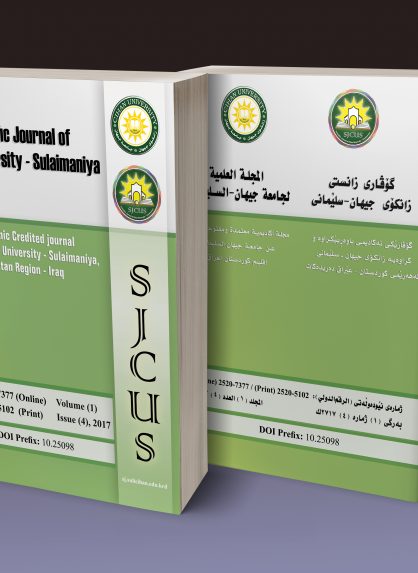| published |
| DOI
http://dx.doi.org/10.25098/2.2.30 |
Bakhtiar S. Hama
English Department, College of Basic Education , University of Sulaimani , Kurdistan Region , Iraq
English Department , Cihan University-Sulaimani , Kurdistan Region , Iraq
bakhtiar [email protected]
Received : 28-1-2018 Revised:23-4-2018
Accepted :29-4-2018 Published :31-12-2018
Abstract
In Jungian Psychology, Ego death is known as psychic death. It simply means that the person improves his/her past life and makes radical changes in it as if he was born again; he goes from one stage to another to start life anew. This transformation of the psych is crucial for human beings to rebuild their lives if the ego death is positive. In this case, mind will become a tabula rasa and the persons can design a beautiful future on it. Unfortunately, the metamorphosis or the ego death in Ionesco’s Rhinoceros is mostly negative. The characters, except Berenger, become rhinoceroses; they lose their subjective identity one after another. Their change is not to return to their pure origin as human beings but to become a dangerous beast. The characters know the conversion is epidemic; yet they do not resist it. On the contrary, they go out and some of them happily receive it, like Daisy. They admire their new form and are happy with it as if being an animal was better than being a man in the current status. This study shows that humanity is in danger and also clarifies that human beings are fed up with being humans. They take new forms and risk man values and features hoping that they can find a meaning for their lives, but they fail. Almost all the characters, cattle-like, follow the bad norm, but Berenger refuses to surrender and embrace the transformation since he believes that it is better to change the essence not the form. He saves his self-identity while others are losing theirs, though it is very hard.
Keywords: ego, ego death, negative ego death, positive ego death, cattle-like
پوخته
لە لێکۆڵینەوە سایکۆلۆژییەکانی کارل جەنگدا، مەرگی خود بە مەرگی دەررونی ناوبراوە. واتە مرۆڤەکان ژیانی رابردوویان بەرەوباشتر دەبەن و گۆرانکاری بنەرەتی تێدادەکەن وەک ئەوەی سەرلەنوێ لەدایک بوبێتنەوە. ئەم گۆرانکارییە دەروونیە زۆر گرنگە بۆ مرۆڤەکان بۆ ئەوەی سەرلەنوێ ژیانیان رێکبخەنەوە ئەگەر هاتوو ئەو گۆڕانە بەشێوەیەکی ئەرێنی بێت. لەم کاتەدا، دەروون وەک پەڕەیەکی سپی لێدێت و مرۆڤەکان دەتوانن داهاتویەکی جوانی لەسەر بنەخشێنن. بەداخەوە، ئەو گۆڕانە دەروونییە، یان مەرگە دەروونییە،ی لە شانۆگەری “کەرکەدەن” دا بەسەر کارەکتەرەکاندا دێت بەزۆری نەرێنییە. کارەکتەرەکان، جگەلە بێرینگەر، هەموویان دەبن بە کەرکەدەن، یەک لەدوای یەک ناسنامەی کەسێتی خۆیان لەدەست دەدەن. ئەو گۆڕانەی لەواندا روودەدات نایانگێڕێتەوە بۆ بنچینە پاکژەکەی خۆیان وەک مرۆڤ بەڵکو دەیانکات بە گیانەوەرێکی دڕندە. دەزانن ئەو گۆڕانە وەک پەتایەکی پیس خێرا بڵاودەبێتەوە، بەڵام بەرەنگاری ناکەن، بگرە هەندێکیان زۆر بەخۆشحاڵییەوە پێشوازی لێدەکەن، وەک دەیزی. زۆر دڵخۆشن بە شێوە نوێیەکەیان وەک ئەوەی بوون بە کەرکەدەن زۆر باشتربێت لە مرۆڤبوون لەوبارودۆخەی ئێستادا. ئەم توێژینەوەیە دەریدەخات کە مرۆڤایەتی لەمەترسیدایە، وەچۆن مرۆڤەکان بێزاربوون لە مرۆڤبوون. مرۆڤەکان شێوەیەکی نوێ وەردەگرن و بەها و خاسیەتە مرۆییەکان دەخەن مەترسییەوە بەوهیوایەی بتوانن مانایەک بۆ ژیانی خۆیان بدۆزنەوە، بەڵام سەرکەوتوونابن. سەرجەم مرۆڤەکان ،مێگەلئاسا، ملی رێدەگرن و دەبن بە کەرکەدەن، بەڵام بێرینگەر ئەو گۆڕانکارییەی بەوجۆرە پێ قبوڵناکرێت و پێیوایە پێویستە گۆڕانکاری بنچینەیی لە مرۆڤەکاندا رووبدات نەک تەنها لە شێوەو رووخساریاندا. لەکاتێکدا کارەکتەرەکان خۆیان وندەکەن، بێرینگەر ناسنامەی کەسێتی خۆی رزگاردەکات، هەرچەندە بۆی ئاسان نابێت.
وشەسەرەکییەکان: خود، مەرگی خود، مەرگی خودی ئەرێنی، مەرگی خودی نەرێنی، مێگەلئاسا
الملخص
يُدعى الموت الانا في علم النفس اليونغي (نسبة للعالم كارل يونغ) الموت النفسي. ويعني ببساطة أن الشخص يقوم بتحسين حياته الماضية و يحدث بتغيرات جذرية فيها كأنه وُلد من جديد حيث ينتقل من حالة الى أخرى ليبدأ حياة جديدة. أن هذا التحول النفسي هو ذا مغزى كبير للبشر لكي يقوموا ببناء حياتهم من جديد اذا ماا كان الموت الانا ايجابي. في هذه الحالة سيصبح العقل صفحة بيضاء (لوح فارغ) يتمكن من خلاله الاشخاص من ان يصمموا مستقبل زاهيا. لسوء الحظ فان التحول أو الموت الانا في مسرحية الكركدن للكاتب يونيسكو هو سلبي.وتتمثل هذه السلبية بأن تتحول الشخصيات , بأستثناء شخصية بيرنجر, الى ذوات القرون الوحيدة حيث يفقد كل منهم هويته الذاتية الواحد تلو الآخر. حيث أن تحولهم المرجو الى النقاء لا يتحقق بل يتحولون الى وحوش خطيرة. أن الشخصيات في هذا العمل يعلمون ان التحول سيفضي الى وباء الا انهم لا يستطيعون ان يقاوموا هذا الامر. و على النقيض من ذلك, فأنهم يخرجون بهذه الاشكال الى الملأ و بعضهم يتمتع بهذا الامر مثل شخصية ديزي. في حقيقة الامر فانهم يحبواهذا الشكل و يفرحوا به كما لوان التحول الى حيوان هو افضل من كون المرء بشرا في هيأته الاعتيادية. تبين هذه الدراسه أن البشرية في خطر وكيف أن البشر قد سئم كونه بشرا. وهذا يمكن رؤيته جليا من خلال التحول الى اشكال جديدة و المجازفة بالقيم و الخصائص البشرية على امل ان يجدوا معنى لحياتهم ولكنهم يفشلون. و في الغالب فأن كل الشخصيات يتبعون النموذج السيئ الا ان بيرنادا يرفض ان يستسلم و يعانق التحول لانه يؤمن بأنه من الافضل أن يتم تغيير الجوهر و ليس الشكل. وينقذ هويته الذاتية بينما يفقدها الآخرون على الرغم منصعوبة الامر.
REFERENCES
Abbotson, Susan C. W. Thematic Guide to Modern Drama. Greenwood Press. London, 2003.
Baumeister, Roy F. “Self-concept, self-esteem, and identity” in Valerian J. Derlega, Barbara A. Winstead and Warren H. Jones (Eds.), Personality: Contemporary Theory and Research, Third edition (pp. 246-280) Belmont, USA, 2005.
Bloom, Harold. Dramatists and Drama. Chelsea House Publishers, Philadelphia, USA, 2005.
Ionesco, Eugene. Rhinoceros and Other Plays, translated by Derek Prouse, Grove Press, INC., New York, 1960.
Jackson, Ronald L. and Hogg, Michael A. (Eds.). Personal Identity versus Self-Identity. Encyclopedia of Identity, Vol. I. SAGE Publications Inc. USA, 2010.
Leech, Clifford. Tragedy. Routledge, London and New York, 1969.
Ventegodt, Søren and Merrick, Joav. “Measurement of Quality of Life VII. Statistical Covariation and Global Quality of Life Data: The Method of Weight-Modified Linear Regression”, The Scientific World Journal, Vol. 3. PP. 1020-1029, 2003.
.
.



